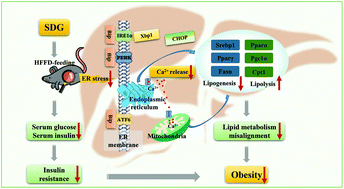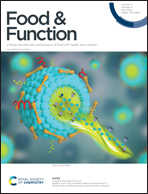Secoisolariciresinol diglucoside alleviates hepatic lipid metabolic misalignment involving the endoplasmic reticulum–mitochondrial axis
Abstract
Secoisolariciresinol diglucoside (SDG) has positive effects on obesity and its complications. We investigated the effects and mechanism of SDG on high-fat and high-fructose diet (HFFD)-induced hepatic lipid metabolic disorders. Supplementation with 40 mg kg−1 d−1 SDG for 12 weeks significantly reduced the body weight and the ratio of liver and adipose tissue to body weight in HFFD-fed mice. Serum and hepatic TG, TC, HDL-C, and LDL-C levels became normalized, and hepatic lipid metabolic disorders lessened because of the downregulation of lipid synthesis genes and upregulation of lipid oxidation genes. SDG also alleviated endoplasmic reticulum (ER) stress and mitochondrial dysfunction by regulating the ER stress factors Bip, IRE1α, Xbp1, Atf6, Perk, and Chop and mitochondrial function-related genes Cox5b, Cox7a1, Cox8b, and Cycs. Results with HepG2 cells confirmed that SDG regulated lipid metabolic disorders by the ER stress-Ca2+-mitochondrial-associated pathway. Our study provides a strategy for the treatment of obesity and its related comorbidities.

- This article is part of the themed collection: Food & Function Recent HOT articles


 Please wait while we load your content...
Please wait while we load your content...